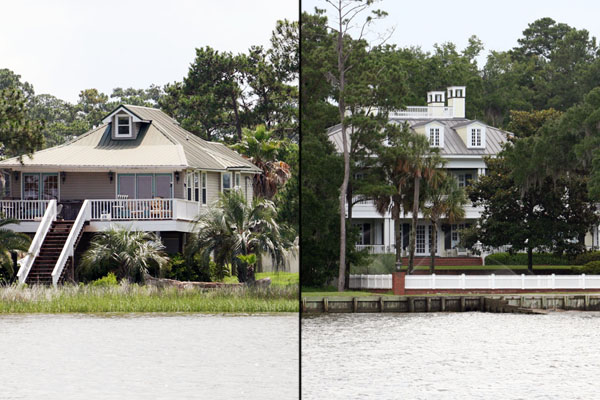by Angela Herring
If you looked up and down the coast of Alabama’s Mobile Bay a half-century ago, you would have seen that roughly 90 percent of its shores were lined with fringing salt marshes and other natural coastal habitats. But today, more than 70 percent of the residential shoreline has been reinforced with vertical walls, erected by homeowners in individual attempts to stave off erosion or, in some cases, as a convenient place to dock one’s boat.
Natural habitats are known to provide a range of “ecosystem services” that benefit not only the marine species that live there, but also their human neighbors. For instance, oysters and other intertidal mollusks filter the water of organic waste runoff and also represent a valuable food source. Steven Scyphers, a post-doctoral research fellow in marine and environmental sciences associate professor Jon Grabowski’s lab at Northeastern’s Marine Science Center, said that one of the major problems with man-made shoreline structures is that they often damage these natural habitats and don’t provide the same benefits.
Furthermore, he said, they’re expensive. “People think vertical walls are less expensive than regular maintenance of a natural shoreline, but it’s actually two times as costly,” he explained.
In a paper published Friday in the journal Conservation Letters, Scyphers and his colleagues at the University of South Alabama and the Dauphin Island Sea Lab present research examining the values and decision-making processes of waterfront homeowners. The goal of the research, he said, is to identify conservation strategies that are most likely to succeed given the need for stakeholder buy-in.
Scyphers is interested in how homeowners manage their shorelines, because this is where individual changes are happening quickly and consistently. “It’s not just one large-scale conservation project—it’s hundreds of thousands of little ones,” he said.
The researchers used a 40-question written survey developed in conjunction with coastal scientists, practitioners, and waterfront homeowners to develop a better understanding of the perceptions and experiences of nearly 400 homeowners on Mobile Bay.

These are two views of shorelines in Mobile Bay in Alabama. At left, a natural shoreline is seen, and at right, a man-made vertical wall is seen. Photos taken by Steven Scyphers.
An analysis of the feedback revealed two important discoveries: First, there was a lot of misinformation regarding the environmental impacts and cost-effectiveness of various shoreline solutions—not only vertical walls, but also things like rocks and simply leaving the natural shore intact. Second, homeowners were much more likely to add a vertical wall to their own property as a response to damage done by a neighbor’s wall.
“The decision of one neighbor to build a vertical wall can cascade down the shoreline,” Scyphers said. He noted that the most common form of shoreline intervention—vertical walls—is also the most damaging because for more than half a century, conservation policies have favored this kind of infrastructure.
The study’s results give Scyphers and his team valuable data for informing future policy measures. The cascading phenomenon, Scyphers said, suggests that perhaps the most important places to protect are long, existing stretches of undeveloped shoreline. Conservation efforts, he noted, should focus on restoring habitats in the most degraded areas as best as possible, but policy should focus on promoting better decisions among homeowners. That latter effort will require working collaboratively with homeowners to understand and develop the best solutions that benefit them and coastal ecosystems, according to Scyphers, whose research is also focused on living shorelines.
Solutions range from man-made oyster reefs to salt marshes, which reduce erosion by absorbing wave impacts without the negative effects brought on by seawalls. Furthermore, these so-called “green” or “nature-based” approaches actually promote habitat for the local ecosystems rather than degrading it.
“The overwhelming majority of homeowners want what’s best for the Bay as long as it protects their property and is cost effective,” Scyphers said. The key to succeeding on that front, he explained, is getting the homeowners accurate information about their various choices before they make their decisions.
